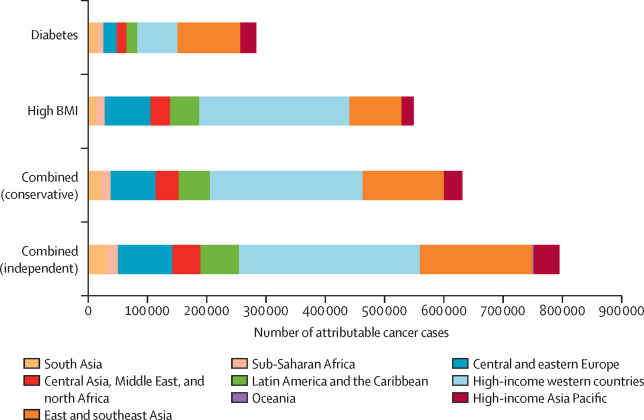Our official English website, www.x-mol.net, welcomes your feedback! (Note: you will need to create a separate account there.)
Worldwide burden of cancer attributable to diabetes and high body-mass index: a comparative risk assessment.
The Lancet ( IF 168.9 ) Pub Date : 2017-11-28 , DOI: 10.1016/s2213-8587(17)30366-2 Jonathan Pearson-Stuttard 1 , Bin Zhou 1 , Vasilis Kontis 1 , James Bentham 2 , Marc J Gunter 3 , Majid Ezzati 4
The Lancet ( IF 168.9 ) Pub Date : 2017-11-28 , DOI: 10.1016/s2213-8587(17)30366-2 Jonathan Pearson-Stuttard 1 , Bin Zhou 1 , Vasilis Kontis 1 , James Bentham 2 , Marc J Gunter 3 , Majid Ezzati 4
Affiliation

|
BACKGROUND
Diabetes and high body-mass index (BMI) are associated with increased risk of several cancers, and are increasing in prevalence in most countries. We estimated the cancer incidence attributable to diabetes and high BMI as individual risk factors and in combination, by country and sex.
METHODS
We estimated population attributable fractions for 12 cancers by age and sex for 175 countries in 2012. We defined high BMI as a BMI greater than or equal to 25 kg/m2. We used comprehensive prevalence estimates of diabetes and BMI categories in 2002, assuming a 10-year lag between exposure to diabetes or high BMI and incidence of cancer, combined with relative risks from published estimates, to quantify contribution of diabetes and high BMI to site-specific cancers, individually and combined as independent risk factors and in a conservative scenario in which we assumed full overlap of risk of diabetes and high BMI. We then used GLOBOCAN cancer incidence data to estimate the number of cancer cases attributable to the two risk factors. We also estimated the number of cancer cases in 2012 that were attributable to increases in the prevalence of diabetes and high BMI from 1980 to 2002. All analyses were done at individual country level and grouped by region for reporting.
FINDINGS
We estimated that 5·6% of all incident cancers in 2012 were attributable to the combined effects of diabetes and high BMI as independent risk factors, corresponding to 792 600 new cases. 187 600 (24·5%) of 766 000 cases of liver cancer and 121 700 (38·4%) of 317 000 cases of endometrial cancer were attributable to these risk factors. In the conservative scenario, about 4·5% (626 900 new cases) of all incident cancers assessed were attributable to diabetes and high BMI combined. Individually, high BMI (544 300 cases) was responsible for twice as many cancer cases as diabetes (280 100 cases). 26·1% of diabetes-related cancers (equating to 77 000 new cases) and 31·9% of high BMI-related cancers (174 040 new cases) were attributable to increases in the prevalence of these risk factors from 1980 to 2002.
INTERPRETATION
A substantial number of cancer cases are attributable to diabetes and high BMI. As the prevalence of these cancer risk factors increases, clinical and public health efforts should focus on identifying optimal preventive and screening measures for whole populations and individual patients.
FUNDING
NIHR and Wellcome Trust.
中文翻译:

全球可归因于糖尿病和高体重指数的癌症负担:比较风险评估。
背景技术糖尿病和高身体质量指数(BMI)与几种癌症的风险增加相关,并且在大多数国家中,其患病率正在增加。我们根据国家和性别,将归因于糖尿病和高BMI的癌症发病率估计为个体危险因素,并综合考虑。方法我们估计了2012年175个国家中按年龄和性别划分的12种癌症的人群可归因分数。我们将高BMI定义为BMI大于或等于25 kg / m2。我们在2002年使用了糖尿病和BMI类别的综合患病率估算,假设暴露于糖尿病或高BMI与癌症发生率之间存在10年的滞后时间,再结合已发表的估算的相对风险,可以量化糖尿病和BMI较高对站点-特定的癌症 作为一个独立的风险因素,在保守的情况下我们假设糖尿病和高BMI的风险完全重叠。然后,我们使用GLOBOCAN癌症发病率数据来估计可归因于这两个危险因素的癌症病例数。我们还估计了1980年至2002年间可归因于糖尿病患病率和BMI升高的癌症病例数。所有分析均在各个国家/地区进行,并按地区分组进行报告。结果我们估计,2012年所有事件中的癌症的5·6%可归因于糖尿病和高BMI作为独立的危险因素,相当于792 600例新病例。这些危险因素归因于766 000例肝癌中的187 600(24·5%)和317 000子宫内膜癌中的121 700(38·4%)。在保守的情况下,评估的所有事件癌症中约有4·5%(626 900个新病例)归因于糖尿病和高BMI。单独而言,高BMI(544,300例)引起的癌症病例是糖尿病(280,100例)的两倍。从1980年到2002年,这些与糖尿病相关的癌症中有26·1%(相当于77 000例新病例)和31·9%与BMI高度相关的癌症(174 040例新病例)是由于这些危险因素的患病率增加所致。解释大量癌症病例归因于糖尿病和高BMI。随着这些癌症危险因素的普及,临床和公共卫生工作应着重于为整个人群和个体患者确定最佳的预防和筛查措施。资助NIHR和惠康基金会。评估的所有事件癌症中约有4·5%(626 900个新病例)归因于糖尿病和高BMI。单独而言,高BMI(544,300例)引起的癌症病例是糖尿病(280,100例)的两倍。从1980年到2002年,这些与糖尿病相关的癌症中有26·1%(相当于77 000例新病例)和31·9%与BMI高度相关的癌症(174 040例新病例)是由于这些危险因素的患病率增加所致。解释大量癌症病例归因于糖尿病和高BMI。随着这些癌症危险因素的普及,临床和公共卫生工作应着重于为整个人群和个体患者确定最佳的预防和筛查措施。资助NIHR和惠康基金会。评估的所有事件癌症中约有4·5%(626 900个新病例)归因于糖尿病和高BMI。单独而言,高BMI(544,300例)引起的癌症病例是糖尿病(280,100例)的两倍。从1980年到2002年,这些与糖尿病相关的癌症中有26·1%(相当于77 000例新病例)和31·9%与BMI高度相关的癌症(174 040例新病例)是由于这些危险因素的患病率增加所致。解释大量癌症病例归因于糖尿病和高BMI。随着这些癌症危险因素的普及,临床和公共卫生工作应着重于为整个人群和个体患者确定最佳的预防和筛查措施。资助NIHR和惠康基金会。
更新日期:2018-01-24
中文翻译:

全球可归因于糖尿病和高体重指数的癌症负担:比较风险评估。
背景技术糖尿病和高身体质量指数(BMI)与几种癌症的风险增加相关,并且在大多数国家中,其患病率正在增加。我们根据国家和性别,将归因于糖尿病和高BMI的癌症发病率估计为个体危险因素,并综合考虑。方法我们估计了2012年175个国家中按年龄和性别划分的12种癌症的人群可归因分数。我们将高BMI定义为BMI大于或等于25 kg / m2。我们在2002年使用了糖尿病和BMI类别的综合患病率估算,假设暴露于糖尿病或高BMI与癌症发生率之间存在10年的滞后时间,再结合已发表的估算的相对风险,可以量化糖尿病和BMI较高对站点-特定的癌症 作为一个独立的风险因素,在保守的情况下我们假设糖尿病和高BMI的风险完全重叠。然后,我们使用GLOBOCAN癌症发病率数据来估计可归因于这两个危险因素的癌症病例数。我们还估计了1980年至2002年间可归因于糖尿病患病率和BMI升高的癌症病例数。所有分析均在各个国家/地区进行,并按地区分组进行报告。结果我们估计,2012年所有事件中的癌症的5·6%可归因于糖尿病和高BMI作为独立的危险因素,相当于792 600例新病例。这些危险因素归因于766 000例肝癌中的187 600(24·5%)和317 000子宫内膜癌中的121 700(38·4%)。在保守的情况下,评估的所有事件癌症中约有4·5%(626 900个新病例)归因于糖尿病和高BMI。单独而言,高BMI(544,300例)引起的癌症病例是糖尿病(280,100例)的两倍。从1980年到2002年,这些与糖尿病相关的癌症中有26·1%(相当于77 000例新病例)和31·9%与BMI高度相关的癌症(174 040例新病例)是由于这些危险因素的患病率增加所致。解释大量癌症病例归因于糖尿病和高BMI。随着这些癌症危险因素的普及,临床和公共卫生工作应着重于为整个人群和个体患者确定最佳的预防和筛查措施。资助NIHR和惠康基金会。评估的所有事件癌症中约有4·5%(626 900个新病例)归因于糖尿病和高BMI。单独而言,高BMI(544,300例)引起的癌症病例是糖尿病(280,100例)的两倍。从1980年到2002年,这些与糖尿病相关的癌症中有26·1%(相当于77 000例新病例)和31·9%与BMI高度相关的癌症(174 040例新病例)是由于这些危险因素的患病率增加所致。解释大量癌症病例归因于糖尿病和高BMI。随着这些癌症危险因素的普及,临床和公共卫生工作应着重于为整个人群和个体患者确定最佳的预防和筛查措施。资助NIHR和惠康基金会。评估的所有事件癌症中约有4·5%(626 900个新病例)归因于糖尿病和高BMI。单独而言,高BMI(544,300例)引起的癌症病例是糖尿病(280,100例)的两倍。从1980年到2002年,这些与糖尿病相关的癌症中有26·1%(相当于77 000例新病例)和31·9%与BMI高度相关的癌症(174 040例新病例)是由于这些危险因素的患病率增加所致。解释大量癌症病例归因于糖尿病和高BMI。随着这些癌症危险因素的普及,临床和公共卫生工作应着重于为整个人群和个体患者确定最佳的预防和筛查措施。资助NIHR和惠康基金会。



























 京公网安备 11010802027423号
京公网安备 11010802027423号